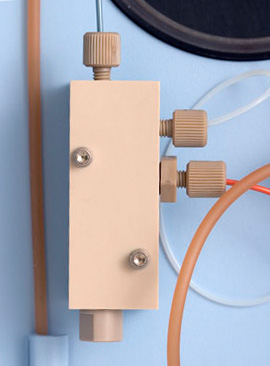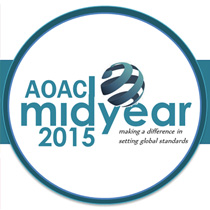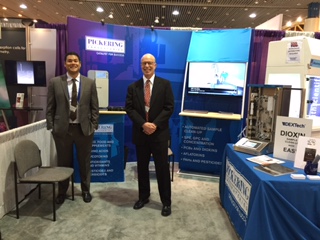
Cleaning and Reassembly of the Over-pressure Relief Valve
-
Remove the tubing connections to the Mixing Manifold. Use a 3/32” hex driver to remove the 2 screws holding the Mixing Manifold to the chassis. Use a 3/8” wrench to remove the end cap and discard the old Over-pressure Relief Valve Cartridge. Ultrasonicate the Mixing Manifold for at least 30 minutes. Rinse well with DI water.
-
Connect the outlet of your HPLC pump to the Mixing Manifold inlet and pump 100% water at 0.5mL/min to verify the Mixing Manifold is not clogged. If the Mixing Manifold is still clogged after cleaning in an ultrasonicating bath, replace the Mixing Manifold Assembly (PN 1452-0040).
-
Turn off the HPLC flow and make sure there is no pressure on the Mixing Manifold. Insert the new OPRV cartridge, green side down, and screw on the end cap to 20”lbs of torque. To approximate this level of torque, first finger tighten, then tighten an additional 1/8-1/4 turn with a 3/8” wrench.
- To verify the opening pressure of the Over-pressure Relief Valve, plug the two side inlets of the Mixing Manifold and turn on the HPLC pump to 0.5mL/min. Allow the pressure to slowly rise. The Over-pressure Relief Valve should open around 485psi. If the opening pressure is too low, tighten an additional 1/8 of a turn with a 3/8” wrench.
David Mazawa
david.mazawa@pickeringlabs.com
Technical Support Chemist
Pickering Laboratories, Inc.
1280 Space Park Way
Mountain View, CA 94043 USA
Phone: (650)694-6700 ext. 710
Fax: (650)968-0749

 AOAC’s 5th Annual Mid-Year Meeting was held in Gaithersburg, Maryland March 16-20. Stakeholders panels, Working groups and Expert Review panels were working on developing consensus standards, evaluating and recommending the methods as well as identifying and prioritizing issues and needs in areas of Infant and Adult nutrition, food and produce safety and Dietary supplements.
AOAC’s 5th Annual Mid-Year Meeting was held in Gaithersburg, Maryland March 16-20. Stakeholders panels, Working groups and Expert Review panels were working on developing consensus standards, evaluating and recommending the methods as well as identifying and prioritizing issues and needs in areas of Infant and Adult nutrition, food and produce safety and Dietary supplements.

 New Orleans, 2015 Pittcon Exhibition – 919 exhibitors, 1,690 booths and an estimated 18,000 attendees. Pickering laboratories exhibited to share the latest products and technologies with customers, distributors and partners. There was a lot of attention to this year’s big introduction, the DEXTech Sample Clean-up system for PCBs and Dioxin. Designed to be faster, cleaner and better automated than industry standard processes the DEXTech provides Dioxin and PCB sample Clean-up at significantly lower price per run while also being faster and safer.
New Orleans, 2015 Pittcon Exhibition – 919 exhibitors, 1,690 booths and an estimated 18,000 attendees. Pickering laboratories exhibited to share the latest products and technologies with customers, distributors and partners. There was a lot of attention to this year’s big introduction, the DEXTech Sample Clean-up system for PCBs and Dioxin. Designed to be faster, cleaner and better automated than industry standard processes the DEXTech provides Dioxin and PCB sample Clean-up at significantly lower price per run while also being faster and safer.
 The 35th annual Natural Products Expo West, the world's largest natural, organic and healthy products event, took place March 4 – 8 at the Anaheim Convention Center in California. The American Herbal Products Association (AHPA), the national trade association that is focused primarily on herbs and botanicals and herbal products, held its annual member meeting and the various committees meeting during this event. This year's meeting featured a keynote speech by Josephine P. Briggs, M.D., Director of the National Center for Complementary and Integrative Health (NCCIH) at the National Institutes of Health (NIH). Her speech focused on research in the diverse medical and health care systems, practices and products that are not generally considered part of conventional medicine. The committee meetings discussed issues that are impacting herbal products industry
The 35th annual Natural Products Expo West, the world's largest natural, organic and healthy products event, took place March 4 – 8 at the Anaheim Convention Center in California. The American Herbal Products Association (AHPA), the national trade association that is focused primarily on herbs and botanicals and herbal products, held its annual member meeting and the various committees meeting during this event. This year's meeting featured a keynote speech by Josephine P. Briggs, M.D., Director of the National Center for Complementary and Integrative Health (NCCIH) at the National Institutes of Health (NIH). Her speech focused on research in the diverse medical and health care systems, practices and products that are not generally considered part of conventional medicine. The committee meetings discussed issues that are impacting herbal products industry They have each won and will shortly be receiving:
They have each won and will shortly be receiving:
